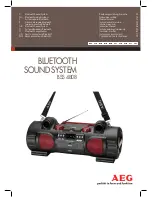
Manual-4
©Rane Corporation 10802 47th Ave. W., Mukilteo WA 98275-5000 USA TEL 425-355-6000 FAX 425-347-7757 WEB rane.com
Operating Instructions
Insuring the proper level of gain though the ME15S is just as im-
portant as adjusting the equalizer bands. Improper gain distribu-
tion is a common cause of loss of system headroom and less than
optimum noise performance.
The OverLoad LED informs of an imminent or passed
overload to the equalizer. Occasional blinking of the OL with
program source material is fine, indicating optimized signal-to-
noise performance of the ME15S. Run the ME15S with an input
signal that is as hot as possible without the OL lighting more
than occasionally.
The BYPASS switch allows comparison of equalized versus
un-equalized signal. It is also useful in adjusting the level of the
ME15S for unity gain and best signal-to-noise performance. The
gain of the ME15S is optimized when there is no sound level dif-
ference between the bypassed and the active positions.
The overall gain range of the level control for the ME15S is
off to +6 dB for unbalanced operation, or off to +12 dB for bal-
anced operation. The level difference between the equalizer in
bypass or active can be significant. Adjust the LEVEL control so
the signal level is the same between the bypassed and active posi-
tions of the BYPASS
switch.
GETTING STARTED
Here is one method of setting your equalizer that works well.
Begin with the following settings:
1. Engage the
BYPASS
switch. (switch depressed,
BYPASS LED
on
.)
2. Put all sliders in their center position (0 dB). The center posi-
tion has a grounded detent.
3. Position the
LEVEL
controls about “6” for unbalanced opera-
tion and “7” for balanced operation.
4. Apply a signal to the system.
5. Verify the
OL
LED is not on—occasionally blinking during
extreme peaks indicates an optimal setting. But if it lights up
a lot or lights steadily, lower the output level of the previous
device in the signal chain.
6. Release the
BYPASS
switch and begin adjusting the equalizer
filters.
7. During filter band adjustments, if the
OL
LED lights more
than occasionally, turn down the output of the previous de-
vice in the signal chain.
8. Once all filter bands are adjusted to your liking, compare the
signal loudness with the equalizer bypassed and active. Adjust
the
LEVEL
controls on the ME15S so there is no difference
between the levels of bypassed versus active.
9. The last step is to reconfirm that the
OL
LED
lights only
when there are large signal spikes in the program material, as
in step 5 above.
For insight into how to use an equalizer, to alleviate acoustic
problems or to adjust the overall tone of the program material,
please read the following two sections.
ACOUSTIC COMPENSATION
A graphic equalizer may be used to correct many acoustic
problems. However, one should fully understand the ramifica-
tions of doing so. Acoustic problems are generally not consistent
across the entire area of sound coverage. This is much more of a
problem when setting up a sound system for large venues. In a
typical large room or hall, there will be areas that have acoustic
reinforcement problems and other areas where certain frequen-
cies are almost entirely canceled out. Try to seek an acoustic
remedy for acoustic problems whenever possible. When this is
not possible or feasible, an equalizer may be used to compensate
for an acoustic problem. But the problem is only improved at
the point where the measurement is taken, other locations in the
room may be adversely affected by the equalizer setting. For this
reason, measure the acoustic response of the system from several
locations and average the equalizer’s setting. Doing this helps
most locations in the venue to have an equal sound quality.
The best way to “see” what the acoustic signature of the room
is doing to sound is to use a real time analyzer or any of the
many computerized measurement systems. Using these devices
to analyze the response of the room and the sound system is the
only accurate means available for setting an equalizer properly.
Equalization can be like spice in the hands of a master chef.
A little goes a long way in improving sound quality, too much
and the mix is spoiled. If modest amounts of equalization (6-8
dB) do not solve the problem, it is best remedied by other means.
Avoid adding large amounts of boost below 63 Hz, especially
when using vented bass cabinets. Boosting frequencies below
the vented enclosure’s low frequency cutoff can easily cause over
excursion of the speaker’s cone, causing premature failure. In ad-
dition, boosting low frequencies can make your power amplifier
run hotter, leading to premature amplifier failure.
When equalizer adjustment is completed, compare the un-
equalized sound with the equalized sound by alternately engag-
ing the BYPASS switch. Use familiar source material and walk
around in the sound coverage area to insure that no anomalies
have been introduced into the sound system. If it sounds good,
you’re done.
TONE CONTOURING
If a ME15S is used for tone contouring by ear, be careful about
adding upper bass (63 Hz to 200 Hz) as this causes “muddi-
ness” or loss of definition. (Also see the previous warning about
boosting frequencies below 63 Hz.) Middle frequency problems
usually express themselves by vocals having a nasal quality (too
much mid band boost) or vocals not being easily understandable
(usually caused by mid band frequencies being under represented
in the overall sound). High band problems show as “sizzle”—
not good, and is sometimes caused by too much high frequency
boosting. This is most obvious with cymbals and hi-hats. To
use the cooking metaphor, high frequencies should simmer, not
sizzle.
109720






















